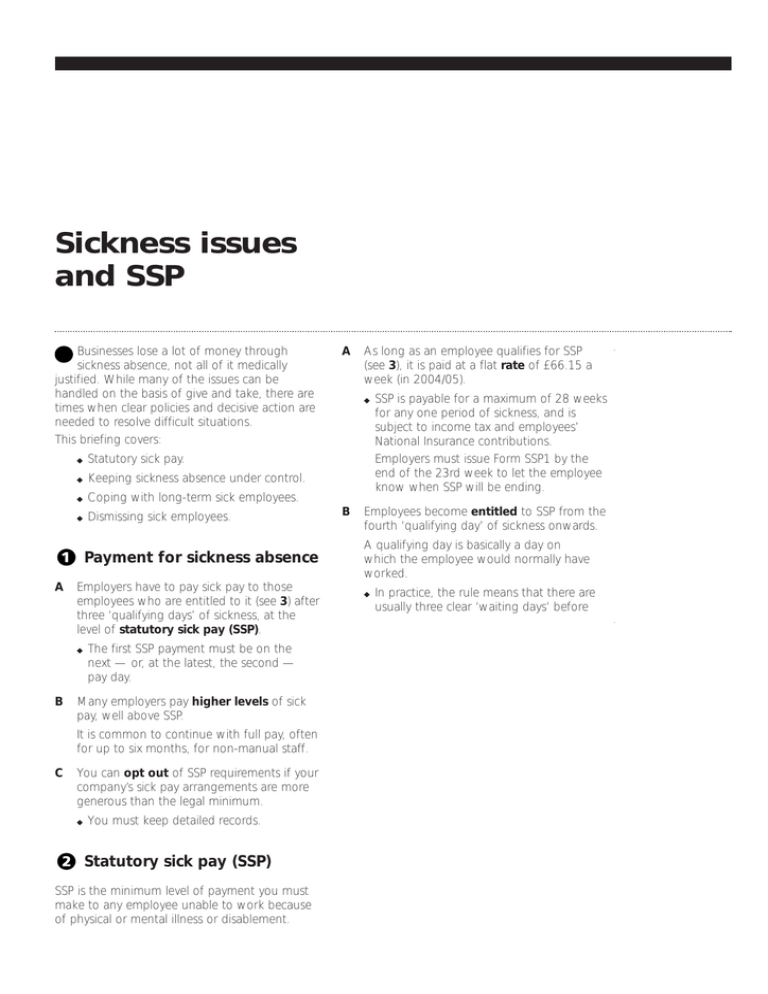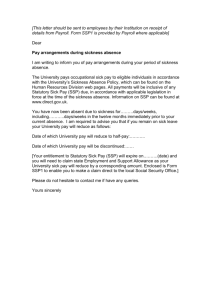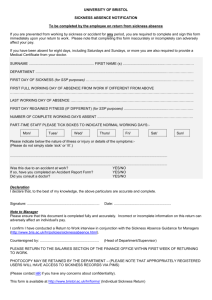Sickness issues and SSP
advertisement

Sickness issues and SSP Businesses lose a lot of money through sickness absence, not all of it medically justified. While many of the issues can be handled on the basis of give and take, there are times when clear policies and decisive action are needed to resolve difficult situations. This briefing covers: ◆ Statutory sick pay. ◆ Keeping sickness absence under control. ◆ Coping with long-term sick employees. ◆ Dismissing sick employees. Payment for sickness absence A Employers have to pay sick pay to those employees who are entitled to it (see 3) after three ‘qualifying days’ of sickness, at the level of statutory sick pay (SSP). ◆ B The first SSP payment must be on the next — or, at the latest, the second — pay day. Many employers pay higher levels of sick pay, well above SSP. It is common to continue with full pay, often for up to six months, for non-manual staff. C You can opt out of SSP requirements if your company’s sick pay arrangements are more generous than the legal minimum. ◆ You must keep detailed records. Statutory sick pay (SSP) SSP is the minimum level of payment you must make to any employee unable to work because of physical or mental illness or disablement. A As long as an employee qualifies for SSP (see 3), it is paid at a flat rate of £66.15 a week (in 2004/05). ◆ B SSP is payable for a maximum of 28 weeks for any one period of sickness, and is subject to income tax and employees’ National Insurance contributions. Employers must issue Form SSP1 by the end of the 23rd week to let the employee know when SSP will be ending. Employees become entitled to SSP from the fourth ‘qualifying day’ of sickness onwards. A qualifying day is basically a day on which the employee would normally have worked. ◆ In practice, the rule means that there are usually three clear ‘waiting days’ before SSP is payable in any ‘period of incapacity for work’ (PIW). ◆ C If the employee is sick on a weekend day or a Bank Holiday — or any other nonworking day — this counts towards the four-day PIW, but is not a ‘qualifying day’. Employers must keep full records of SSP. ◆ Records must be kept for three years. ◆ Failure to do so can lead to a £1,000 fine. D You can get money back from the Inland Revenue if the SSP you pay out exceeds a set level. ◆ Who qualifies for SSP? SSP is for all employees, full-time or part-time, who are unable to work because of sickness and who earn enough to qualify. A You must pay SSP to any employee over 16 and under 65 who is unfit for work. ◆ B The employee’s earnings must be over the NI lower-earnings limit of £79 a week. C You can withhold SSP if the employee: If your SSP exceeds 13 per cent of your gross NI contributions in any month (which is unusual), you can reclaim the extra in full. You do this by deducting the amount first from your NI payments and then from the PAYE you are due to pay. ◆ Is on a temporary contract lasting less than three months. ◆ Has recently drawn a state benefit (such as sickness, incapacity or maternity benefit). ◆ Is held in custody. Tracking sickness absences Backs, stress and headaches The invisible ailments — bad backs, stress and headaches — cause more pain and suspicion in the workplace than any other sickness issues. The key to controlling this kind of absence is to stress that anyone unable to attend work regularly must realise his or her job is at risk, whether the absence is genuine or not. You must have clear rules and show employees they are enforced. A Tell employees they (or someone else) must notify you by telephone that they are sick by, say, 10am on the first day. B Interview all employees on their return. ◆ There may be things you can do to prevent a recurrence of the ailment. For example, providing better seating for an employee with back problems. ◆ Return-to-work interviews are the first line of defence against abuse of the system. A Employees with any of these persistent health problems should be encouraged to seek proper medical advice. ◆ B C If they refuse, or no improvement is seen, they may need to be told that their level of absence is unacceptable to the business. Make it clear that the next step may be to start the disciplinary procedure, which could lead to dismissal. You can ask the Inland Revenue to provide a medical examination for anyone who has had four periods of self-certificated illness, leading to SSP payments, in a year. No business can afford to carry employees who keep missing work, especially if other employees believe the sickness is exaggerated. The costs must be judged in terms of both cash and morale. D If you believe someone is exploiting the system, consider dismissing the offender (after following disciplinary procedures) and risking the chance of a tribunal hearing. Often, you will hear no more from the person you have dismissed. There is no qualifying length of service or minimum number of hours a week. C Ask employees who are off sick for less than seven days to fill in a self-certificating form, giving the reason for their absence. ◆ Insist on a specific description — eg food poisoning, rather than upset stomach. One of the things you want to be able to track is whether it is the same as last time. ◆ You can design your own form, or use self-certification form SC2 from the Inland Revenue. Form SC2 does not say that giving false information is a disciplinary offence and has no place for a supervisor to sign. You may want your form to include these. D Insist on a doctor’s certificate for all periods of sickness of more than seven days. A pattern of absence Those who set out to exploit the system unfairly page 2 often fall into habits of abuse. These habits may show up as patterns in your personnel records. C ◆ Some people seem to fall ill when fine weather arrives. The employee may have continuing difficulties at work, or at home. ◆ Repeated absences involving Mondays and Fridays may be particularly significant. There may be chronic health problems that need to be addressed. ◆ Disciplinary action may be needed. A Be on the alert for lots of short absences. ◆ ◆ ◆ B Whichever it is, you need to know. Consider providing counselling, instead of embarking on the formal disciplinary procedure. People who are working too many hours, for whatever reason, tend to be off sick more than others. A pattern of absences coinciding with major sporting events is always suspicious. ◆ Wimbledon fortnight, Test matches and highlights of the soccer season may trigger increased levels of unauthorised absence. Reducing sickness absences A Create a good working environment. Rules of thumb Even dedicated employees will occasionally need time off for visits to the doctor or dentist or for hospital treatment. Be sympathetic, but let employees know that you expect them to take a reasonably constructive attitude. B A Make it clear that you expect employees, where possible, to arrange appointments for the beginning or end of the day, in order to minimise lost time. B C You may ask to see an appointment letter or card. ◆ If a course of treatment is involved, this may indicate how long it will last. ◆ There is often no documentary evidence available for a one-off visit to the GP. If you have real doubts, seek permission to contact the doctor or dentist directly. Encourage people recovering from injury or illness not to prolong their absence. ◆ ◆ Offer to send a taxi, or arrange a lift, for someone getting over a broken leg. C ◆ You may insist that paid holiday time must be taken for purely cosmetic surgery. Invest in ergonomically sound furniture, lighting and equipment. ◆ Enforce health and safety standards (see Health and safety, LA 3). ◆ Encourage teamwork, contact between people and positive motivation. Recognise that young people and new employees are especially prone to short sickness absences. ◆ Provide close management supervision and encouragement. ◆ Well-thought-out training programmes will improve attendance. Move sick or injured employees to other duties not affected by their condition. All your employees share an interest in seeing that the few who try to exploit the sickness provisions are brought into line. A Spell out, in your disciplinary procedure, the consequences of wilful absenteeism. Suggest light duties or part-time work for an employee who is not fit enough to do what he or she normally does. Varicose veins, hernias, piles, lumps and bunions may all lead to employees needing time off sick. Operations like this will make the people involved more comfortable and productive on their return to work. ◆ Sickness and discipline D Recognise that NHS patients may have little choice about when to have important but non-urgent surgery. E A combination of frequent lateness and one-day absences demands investigation. ◆ Any procedure must be seen to be fair, objective and consistently applied. ◆ If you discover that an absentee has not been genuinely ill, you will probably wish to activate your formal disciplinary procedure (see E). ◆ This could eventually lead to sanctions (eg loss of benefits), or even to dismissal. If you dismiss, you may have to be able to satisfy an employment tribunal that the dismissal was fair (see 9). B You can withhold SSP if you reasonably suspect an employee is not ill. C If you want to stop paying SSP to an employee after four or more absences in a page 3 year, seek an adjudication from Inland Revenue Medical Services. ◆ Write to your local Inland Revenue office enclosing the employee’s written permission for Medical Services to become involved and any medical certificates he or she has supplied. ◆ If the employee refuses to give permission, this may be grounds to stop SSP. ◆ Medical Services will get a report from an employee’s GP, and may conduct its own examination, before deciding if SSP can be withheld. D Always tell employees if levels of sickness absence are putting their jobs at risk. E If the disciplinary procedure is invoked, make it clear that it is the repeated absence from work, and thus the employee’s ‘capability’ to do the job, that is causing the problem. ◆ asthma and ME, can be regarded as disabilities. ◆ Dismissal Ultimately, you can dismiss a person for reasons of sickness if you can show you have considered all the alternatives and consulted the employee. A You can dismiss a sick employee at any time when it is reasonable to do so. If the process ends in dismissal and a tribunal hearing, it is much easier to justify dismissal on grounds of lack of capability than to get involved in arguments about whether illnesses were real or not. ◆ In established companies, this may mean waiting for the full 28-week SSP period. ◆ In a small firm with a handful of employees, where a gap in the ranks could threaten the business, it might be reasonable to dismiss very much sooner. An employee in a permanent coma after an accident might reasonably be dismissed within a few weeks. Long-term sickness A Do not abandon an employee who is on long-term sick leave. Arrange progress reports and home visits. B ◆ Consider arranging or paying for treatment that could speed up a return. ◆ Make the employee aware of his or her position. Just knowing there is a job to come back to can help people’s recovery. C You will need to have gathered all the facts, including full medical information, to show that the dismissal is reasonable. C Contact the employee’s GP, with his or her permission, and get a medical assessment. Suggest a staged return to work, on a part-time basis, building up to full time. Explore the possibility of alternative duties. ◆ Could the employee come back and do lighter work? D If a return looks unlikely after a long illness, consider offering early retirement, perhaps with enhanced pension arrangements. E B After a long time away, an employee may feel fear about returning, especially if the absence resulted from an industrial accident. ◆ If dismissals resulting from long-term sickness involve people with disabilities, they must be for ‘a substantial and material reason’. ◆ It may not always be obvious what is a disability and what is not. Long-term health problems, including You are under a positive duty to make reasonable adjustments to the job, or the way it is done, to stop a disabled person being at a substantial disadvantage. Businesses employing fewer than 15 people are exempt from these provisions, although this exemption will be removed in October 2004. ◆ The employee has the right to refuse permission, or to see the doctor’s report and to request amendments to it. In case of doubt, ask the employee to agree to an independent examination. ◆ If you get no co-operation, explain that a decision will be taken on the basis of available information and that this might result in dismissal. D If there is no serious prospect of an eventual return to work, explain to the employee that the job can no longer be kept open. E Confirm the dismissal, giving the appropriate written notice and the appropriate pay. (See Dismissing employees, HR 5.) Follow your procedures to the letter, as you may have to justify the fairness of your decision to an employment tribunal. (See Employment tribunals, HR 21.) page 4



